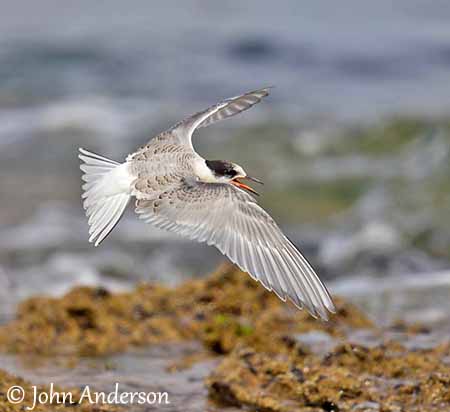
Fr: Sterne arctique
Ang: Arctic Tern
All: Küstenseeschwalbe
Esp: Charrán Artico
Ita: Sterna codalunga
Nd: Noordse Stern
Sd: Silvertärna
Photographers:
John Anderson
John Anderson Photo Galleries
Steve Garvie
RAINBIRDER Photo galleries
Otto Plantema
Trips around the world
Ingo Waschkies
My bird pictures on Pbase
Text by Nicole Bouglouan
Sources:
HANDBOOK OF THE BIRDS OF THE WORLD Vol 3 by Josep del Hoyo-Andrew Elliott-Jordi Sargatal - Lynx Edicions - ISBN : 8487334202
L’ENCYCLOPEDIE MONDIALE DES OISEAUX - Dr Christopher M. Perrins - BORDAS - ISBN: 2040185607
THE COMPLETE BOOK OF BRITISH BIRDS – Written by “Royal Society for the Protection of Birds” experts - Préface de Magnus Magnusson - Michael Cady- Rob Hume Editors - ISBN: 0749509112
BirdLife International (BirdLife International)
Wikipedia, the free encyclopaedia
All About Birds (Cornell Lab of Ornithology)
Bird Web (Seattle Audubon Society)
Animal Diversity Web (University of Michigan Museum of Zoology)
Arctic Tern
Sterna paradisaea
Charadriiformes Order – Laridae Family
INTRODUCTION:
The Arctic Tern is a medium-sized seabird well known for its extremely long migration between its breeding areas in high Arctic and its wintering grounds in Antarctic where it remains for only three or four months. This type of migration allows the bird to avoid the full effect of the winter, and to benefit from the best moment for breeding or wintering in different hemispheres and during summer.
To perform such migration, the Arctic Tern needs important food sources. It stops during a month to feed on fish and crustaceans in the North Atlantic Ocean, before to follow its route and cross the tropics.
From a 2010 study, we learn that the bird follows meandering rather than straight routes, in order to take advantage of the spiralling wind patterns to avoid flying into the wind.
The Arctic Tern may travel more than 70,000 kilometres every year, and it spends most of its life flying. It is rarely seen resting on the water, but during the long migration, it can be seen perched on floating debris or logs.

DESCRIPTION OF THE BIRD:
Biometrics:
Length: 33-36 cm
Wingspan: 76-85 cm
Weight: 86-127 g
This small tern has brighter colours in breeding plumage. Its plumage is pale grey with slightly paler underparts and white vent, rump and tail. The long streamers make this bird very elegant both in flight and on the ground. Crown and forehead are black, contrasting with a small, narrow white area on the cheeks.
On the wings, the grey inner webs and the narrow black line along the tips of the outer primaries, paler on the secondaries, form a translucent “window” conspicuous in flight.
The adult in breeding plumage has red bill, legs and webbed feet while the eyes are dark brown.
In non-breeding plumage, the forehead is white whereas bill, legs and feet are blackish. Both sexes are similar.
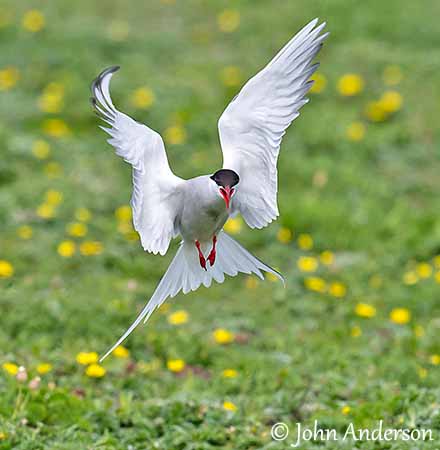
The juvenile has darker upperparts with brown-tipped feathers on mantle and inner wing. The head is similar to adults in non-breeding plumage. Bill, legs and feet are dark pinkish with black areas.
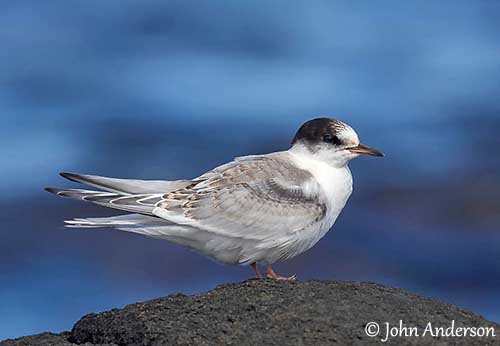
RANGE:
The Arctic Tern breeds in a circumpolar distribution including Arctic and sub-Arctic parts of Europe (as far as Brittany), Asia and North America (as far as Massachusetts).
It performs a long migration to spend the winter in the Antarctic, by following a zigzagging route from continent to continent.
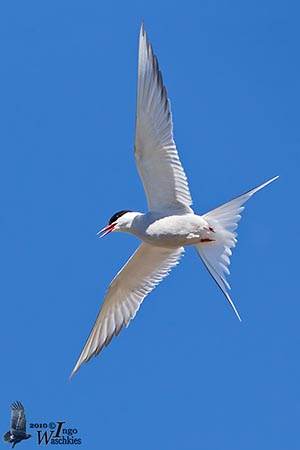
HABITAT:
The Arctic Tern breeds in colonies established on coasts with the nests made on shingle beaches or gravel ridges and rocks covered with lichens. But it can breed also far inland in tundra near water, barren fields, grassy meadows and pastures, and islands in lakes or coastal lagoons.
During winter in the Antarctic, the Arctic Tern is highly pelagic and can be seen from the open sea to the pack ice area. It often rests on flotsams.
It moults during this period, and remains flightless for a time.
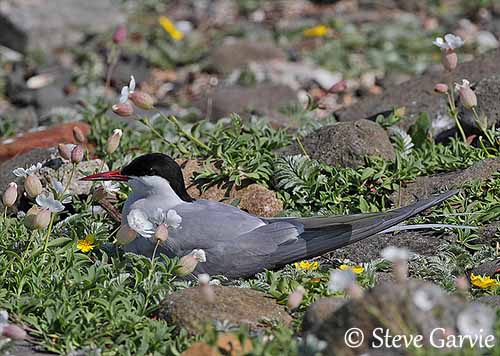
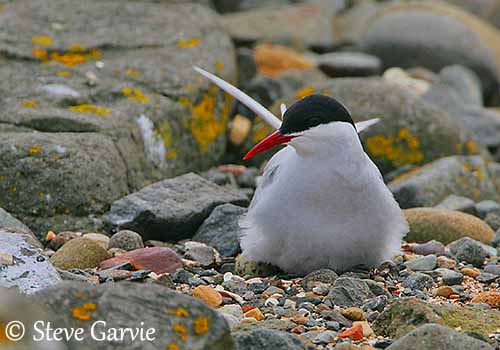
CALLS AND SONGS: SOUNDS BY XENO-CANTO
The Arctic Tern utters nasal, grating “pee-airr”, and “kik”, also a shrill piping “tcheek” and rising “kee kee, keeyah”.
The birds are very noisy at colonies and especially during the displays.
BEHAVIOUR IN THE WILD:
The Arctic Tern feeds primarily on small fish, but it also takes crustaceans, molluscs and insects. It takes advantage of fish offal too.
On land, it feeds on caterpillars and earth worms. It may occasionally feeds on berries in early spring. Insects are taken on the breeding grounds, but the chicks are mainly fed on fish.
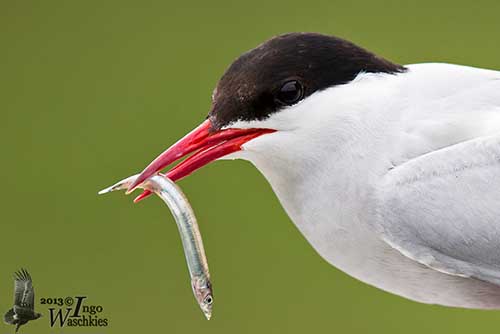
The Arctic Tern forages by hovering in mid-air while searching for prey, before to dive into the water for catching it. It may also dip down to the surface when a prey is swimming close to it.
It can occasionally steal food from other birds. It flies at its victim and startles the bird, forcing it to regurgitate its preys.
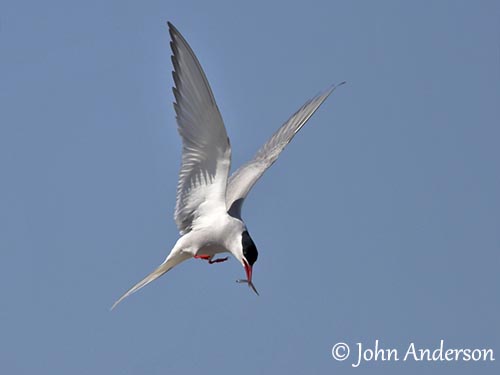
The Arctic Tern usually mates for life, starting to breed at 3-4 years old. The pair returns to the same colony every year.
They are very territorial and perform aggressive displays against other terns. They walk or fly towards the opponents and fights and aerial chases often occur.
The usual territorial display is often used between neighbours. They rise in half-hovering flight, sometimes flying at one another bill-first. These fights may occur high in the air.
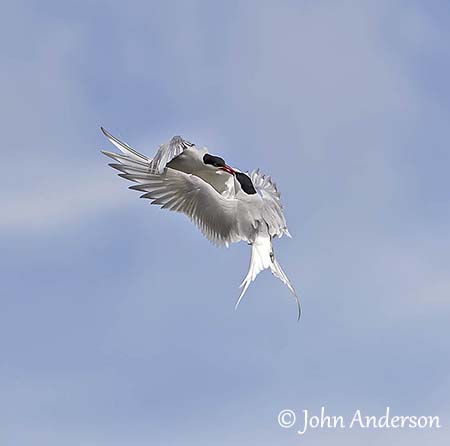
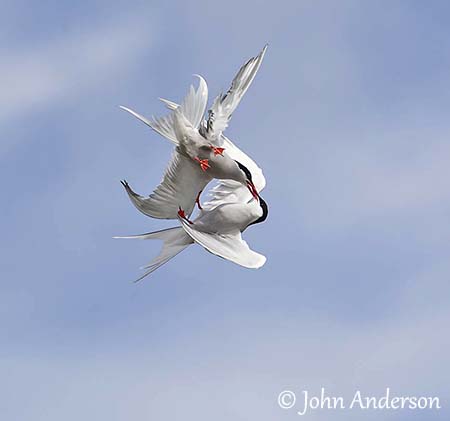
The Arctic Tern performs elaborate courtship displays, starting with the “high-flight”, followed by the “fish-flight”. Both sexes fly high in the air, alternating flapping flight with glides. This flight begins when the male offers a fish to the female before they take-off together.
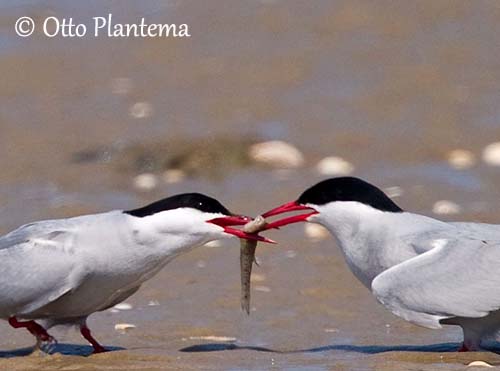
Once the pair is formed, the displays accelerate with the addition of courtship feeding. Prior to copulation, the mates circle around each other with slightly drooped wings and bill pointed downwards. Then, the male points the bill up while calling softly. This display usually lasts several minutes, followed by copulation.
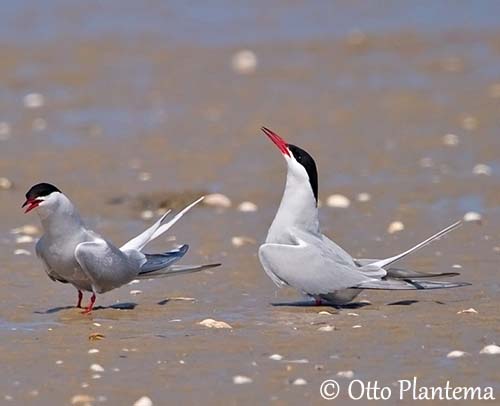
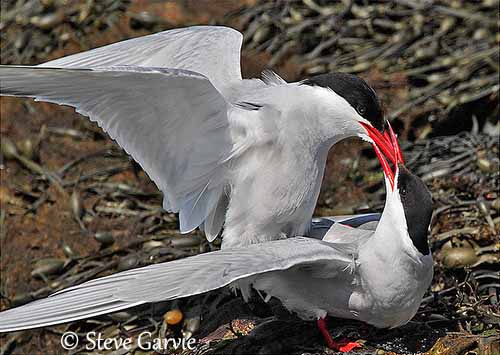
Both sexes defend the nest-site. The Arctic Tern attacks all intruders, even humans and large predators approaching the nest, by striking them on head or back.
They nest in colonies of 5 to 25 pairs, but sometimes up to 300 pairs, but they may occasionally nest solitary.
The long migration of the Arctic Tern occurs every year from the Arctic breeding grounds to the Antarctic wintering areas. These birds may travel up to 70,000 kilometres each year.
They follow a zigzagging route rather than a straight route in the middle of the Atlantic Ocean, from one continent to another. This strategy allows the bird to benefit from spiralling wing patterns and to avoid flying into the wind.
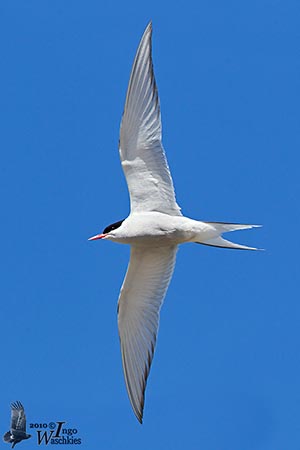
The Arctic Tern has swift and graceful flight. Its distinctive silhouette is very elegant when crossing the blue sky. These birds are very agile when feeding, hovering and diving repeatedly. It is an excellent flier able to travel extremely long distances while migrating.

REPRODUCTION OF THIS SPECIES:
The laying varies with temperatures and food resources, but usually occurs in May-June.
The Arctic Tern nests in colonies and often returns to the same breeding sites in several following years.
The nest is a hollow on the ground, a shallow scrape often unlined, usually in short vegetation, sand or gravel, at a good distance from the water. Within the colony, the nests are more than ten metres apart, and occasionally much closer.
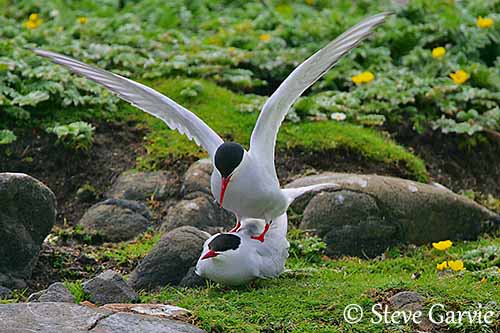
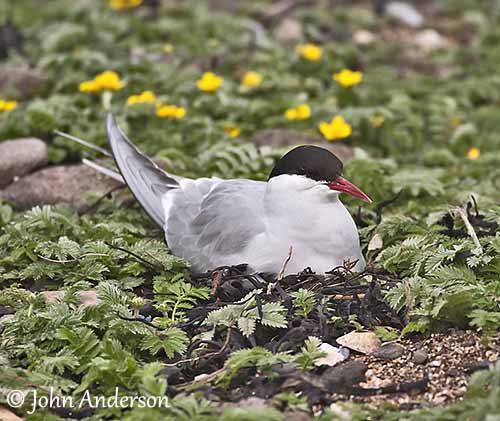
The female lays 1-3 pale olive eggs with blackish markings, a very cryptic colour which makes the eggs almost invisible on sand or gravels. At hatching, the chicks are brownish or greyish with dark markings above, and have whitish underparts, although the chin is grey.
They are fed with fish by both parents and can move around between 1 to 3 days after hatching. They remain near the nest and are brooded for the first ten days. They fledge about 21-24 days after hatching and learn to feed themselves. They will migrate southwards to winter accompanied by their parents.
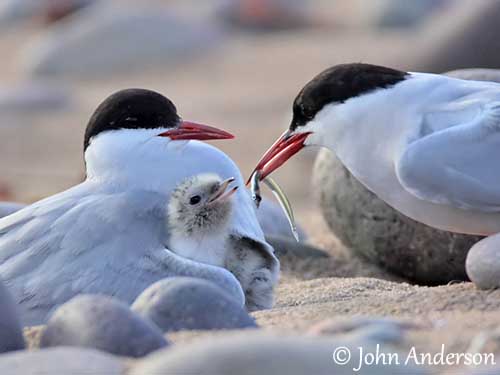
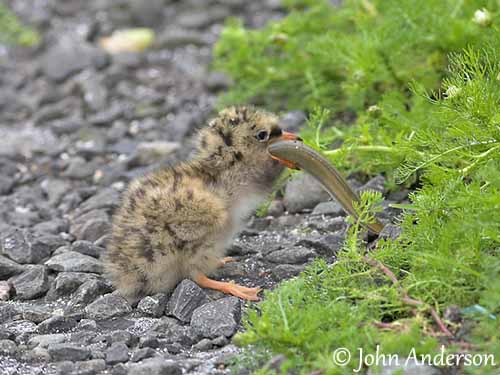
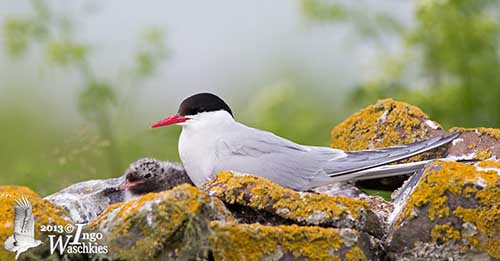
PROTECTION / THREATS / STATUS:
The Arctic Tern is threatened by climate change, food resources availability, nest predators such as other seabirds, hedgehogs, introduced Mustela vison and rats, human coastal developments and disturbances.
The species is protected in some parts of the range such as in Great Britain. However, other type of threat like shooting for fun, especially in Alaska (but probably also elsewhere) may affect the local populations.
Currently, the Arctic Tern is evaluated as least Concern with a global population estimated at 2,000,000 individuals. But the overall trend is decreasing.
